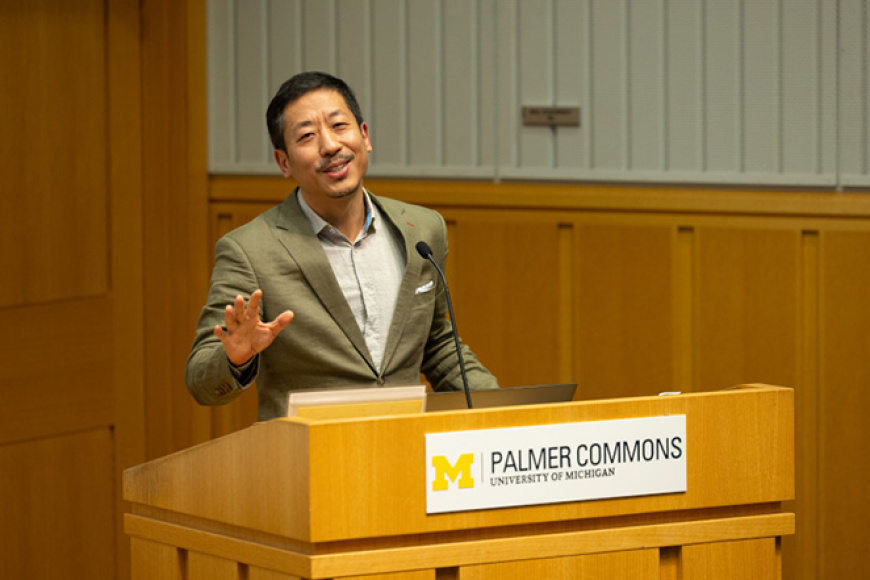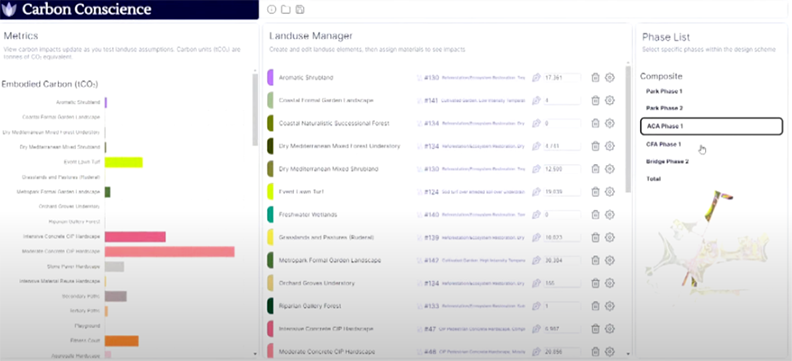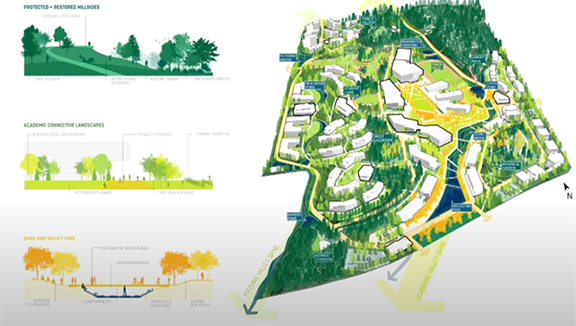
 back to all news
back to all news
Talk by SEAS grad Tao Zhang focuses on ecological design

Tao Zhang (MS/MLA ’08) recently delivered the Clarence Roy-Smith Group JJR Lecture, which is presented by a University of Michigan graduate on a topic related to the theme of sustainability in landscape architecture. Zhang is an award-winning landscape architect, a trained ecologist, and a principal at Sasaki, an integrated design firm based in Boston. He also is a graduate of the Master of Landscape Architecture and Master of Science in Sustainable Systems programs at the U-M School for Environment and Sustainability (SEAS).
The lecture began with SEAS Professor of Landscape Architecture Joan Iverson Nassauer speaking about the impact Zhang’s work has had on the landscape architecture profession. According to Nassauer, Zhang is known for using research in design. She said that understanding his work can lead to a deeper understanding of ecological design.
“Tao’s work really epitomizes ecological design,” she said. “His work is such a wonderful example of being highly creative, while using and generating scientific evidence.”
The theme of Zhang’s lecture was evidence-informed design, the approach to landscape architecture that weaves data and technology into design in order to ask better questions and reveal deeper insights.
“It is important to me to find the best insights from the information available to make the best design decisions,” he said. “Science and creative pursuits are not on the opposite sides. They are complementary, [where] science can be an inspiration.”
Zhang focused his lecture on the projects and research of his firm, Sasaki, and the firm’s nonprofit arm, Sasaki Foundation. According to Zhang, Sasaki is an interdisciplinary practice.
“We cover everything from landscape architecture, ecology, civil engineering, planning and urban design, architecture and interior design, and graphic design,” he said.
SEAS master’s student James Burnham said he was interested to hear how many different disciplines are incorporated into landscape architecture.
“There are so many interesting ways to solve problems, but it is clear [landscape architects] need to talk to ecologists, biologists, water quality experts, and many different [experts] with other areas of knowledge to make a project whole,” he said.
Sasaki devotes a portion of its profits to funding three to four research projects each year proposed by interdisciplinary teams by the staff, according to Zhang.
“Research paves the way for stronger practice,” he said.
Sometimes these proposals become a larger effort, like the Sasaki Carbon Conscience Tool. According to Zhang, decarbonization has become a topic of national interest in the landscape architecture field.
“Landscape architects sometimes tend to talk about decarbonization as a buzzword, so much that it can become so abstract,” he said. “We [want to] create the tools to communicate [about decarbonization] better, instead of talking in a vague way to achieve carbon neutrality.”
Sasaki’s carbon conscience tool examines the potential impact of carbon for the landscape architecture discipline, especially in the early stage of planning and design.
“When you create a proposal, the ideation phase is where the biggest potential impacts are,” he said.

Designers can access this tool on Sasaki’s website for free and use it to qualify and evaluate the carbon footprint impacts of their landscape plan.
“While you cannot know for sure [the carbon impact], you can come to a better conclusion with this evidence-based information,” he said.
SEAS Master of Landscape Architecture student Brooke Bulmash noted that she found the discussion of the carbon calculator tool to be a highlight of the lecture.
“What makes the tool even more remarkable is that it is all open access,” she said. “It is really special that Sasaki is secure in their business model and sees the value in the tool beyond their own company. It shows that they are here for the betterment of society.”
Zhang also discussed Sasaki’s involvement with campus master plans, including Xinyang University and the University of Michigan.
At Xinyang University, Sasaki was interested in integrating the landscape history and characteristics into the campus design. The team wanted to use the topography and other natural amenities to drive the creation of the campus plan, according to Zhang. The hydrology around the site became the inspiration for the campus framework.
 “Water is the key driver of the campus plan,” Zhang said. “We respected the topography as a character. Every drop of water on the campus landscape is from rainwater”
“Water is the key driver of the campus plan,” Zhang said. “We respected the topography as a character. Every drop of water on the campus landscape is from rainwater”
Bulmash found it interesting to hear about a university project that is different from that of U-M.
“It was interesting the way he described how sensitive the campus was to issues like hydrology and how they wanted to create a multi-functional space,” she said.
Zhang is part of the Sasaki team that is working on the U-M Campus Plan 2050. According to Zhang, to conduct a campus plan, designers need to understand the complex needs of the students, staff, and faculty of a university.
Using the process for the Emory College campus plan as an example, Sasaki conducted collaborative surveys, where faculty and staff were asked which departments they collaborate with and who they would want to be situated near on campus. Sasaki then developed a data visualization tool to illustrate the relationship network of collaborations between departments.
“Sasaki develops tools for our projects, depending on the needs for project design,” he said. “We want the tools to help inform better design.”
SEAS Master of Landscape Architecture student Emily Carra said that she attended the lecture to see what career opportunities are available for MLA students after graduation.
“I think seeing real-world examples of jobs we could do after graduation is really important,” she said. “I get asked what I want to do all the time, so I am very interested to see what work is potentially out there.”
Bulmash added that she was excited to hear from a graduate of the MLA program.
“A lot of MLA students want to intern or work at Sasaki, so it is nice to be able to hear about the work of an alum, who has a big leadership position at the firm,” she said.
Carra walked away from Zhang’s lecture understanding how important sustainability is to landscape architecture.
“Informed decision-making to make an impact is really important for sustainability,” Carra said.
Likewise, Bulmash agreed that it is important to highlight the importance of landscape architecture for the environment and sustainability.
“No single discipline is equipped to handle the climate crisis, but this discipline is good at bridging the link between architecture and ecology to find the middle ground of arts and sciences,” she said. “There is a big need for people who think a little differently to apply their skills in order to solve the climate crisis.”

